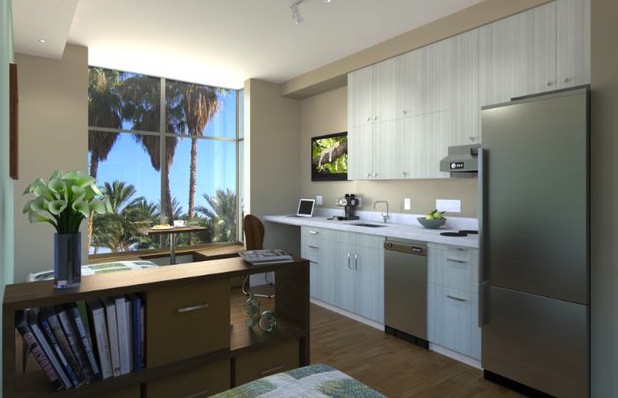New research from the Urban Land Institute suggests that micro units—typically larger than a one-car garage, smaller than a double—have staying power as a housing type that appeals to urban dwellers in high-cost markets who are willing to trade space for improved affordability and proximity to downtown neighborhoods.
The report, "The Macro View on Micro Units," includes an analysis by MPF Research of more than 400 rental apartment communities (comprising more than 90,000 units) built in 2012-2013 in the 35 U.S. metro areas that experienced the highest concentration of multifamily construction during that period. It also includes findings from more than 3,500 responses to an early 2014 survey by Kingsley Associates of renters of both conventional apartments and micro units; and case studies drawn from 30 existing and 18 planned rental communities with micro units that were identified by RCLCO (Robert Charles Lesser & Co.).
The report was prepared for ULI’s Multifamily Housing Councils with support from a grant awarded in 2013 by the ULI Foundation.
Key findings from the report:
• Micro units are typically about 350 square feet in size, but can range from less than 250 square feet to 500 square feet, depending on the city building code requirements. They have no separate bedroom; sleeping space is combined with living space, but they do have fully functional bathrooms and kitchens. Micro unit communities place heavy emphasis on multiple amenities outside the units themselves, such as shared communal spaces that encourage socializing and foster a sense of community.
• The target market profile for micro units is predominantly young professional singles, typically under 30 years of age, earning less than $40,000, trending slightly more toward males than females. Other market segments include couples, older single empty-nesters, and temporary users. Singles currently living with roommates tend to be the most interested in making the switch from a traditional unit to a micro unit.
• The appeal of micro units is largely about economics, as well as place and privacy. Those interested in micro units are seeking to lower their rental costs (the units typically rent for 20 to 30 percent less than larger units); they are also drawn to the trendy “hip” locations where micro units tend to be built, and by the ability to live alone.
• Nearly a quarter of the renters surveyed who live in conventional apartments said they would be interested in renting a micro unit. Fifty-eight percent said they would not be interested, primarily due to the lack of a separate bedroom, less storage space and less living or dining space.
• Those who are interested in switching to micro units ranked access to a grocery store as their top priority for a neighborhood amenity, followed by restaurants and a gym. In terms of project amenities, a laundry room ranked highest, followed by assigned parking, visitor parking, and a fitness center; and for unit amenities, a washer and dryer ranked first, followed by built-in closet/drawers and storage space. More than half were interested in multi-functional, convertible furniture.
• Those currently living in micro units cited location as the top factor influencing their decision to move into the small units, followed by price, proximity to work/education institutions, proximity to neighborhood amenities, the ability to live alone, and proximity to transit.
• Smaller and micro units outperform conventional units in the marketplace, in terms of achieving higher occupancy rates and garnering significant rental rate premiums (rent per square foot) compared with conventional units.
• The market is shifting toward a greater mix of smaller studio and one-bedroom units being included in traditional apartment communities, as well as more construction of micro-unit communities. Studio and one-bedroom units accounted for nearly 51 percent of the 2012-2013 completions, up drastically from 41 percent in 2002-2003.
• Despite the rising popularity of micro units, some developers are building in the flexibility to easily convert two side-by-side units into one larger unit if demand shifts back to more conventional models.
RCLCO’s case study research identifies four trends (primarily associated with Generation Y) that are linked to the rising appeal of the units: delayed household formation, an increase in single-person households, a decrease in car ownership, and the tendency to accumulate fewer belongings and participate in the “sharing economy.”
Among the case studies that contributed to the best practices and lessons learned: Factory 63 in Boston; The Flats in Chicago; Lofts at 7 in San Francisco; Arcade Providence in Providence, Rhode Island; Eko Haus Freedom Center in Portland, Oregon; and My Micro NY in Kips Bay, New York.
“Whether this (increased development of micro units) turns out to be a lasting phenomenon or a passing fad, micro units have renewed the focus on efficient layouts and innovative design solutions,” concludes the report.
Download a free PDF version of The Macro View on Micro Units report.
Related Stories
| Oct 8, 2014
Massive ‘healthcare village’ in Nevada touted as world’s largest healthcare project
The $1.2 billion Union Village project is expected to create 12,000 permanent jobs when completed by 2024.
| Oct 8, 2014
First look: Woods Bagot unveils plans for new Christchurch Convention Center
The locally-inspired building is meant to serve as a symbol of the city's recovery from the earthquake of 2011.
| Oct 8, 2014
Denver transit project wins design-build Project of the Year honor
The Denver Union Station Transit Improvement Project is among 25 projects honored by the Design Build Institute of America for excellence in design-build project delivery.
| Oct 7, 2014
Analysis: Student loans will cost housing industry $83 billion in 2014
More than 410,000 single- and multifamily home sales will be lost in 2014 due to student loan debt, according to analysis by John Burns Real Estate Consulting.
Sponsored | | Oct 7, 2014
Boost efficiency with advanced framing
As architects continue to search for ways to improve building efficiencies, more and more are turning to advanced framing methods, particularly for multifamily and light commercial projects.
| Oct 7, 2014
Economic gains are rallying rents in Raleigh, N.C.
The greater Raleigh, N.C., market appears to be getting back on its feet again, which is good news for rental property owners.
| Oct 7, 2014
Structured, not stirred: The architecture of cocktails [infographic]
In this downloadable graphic, technologist Shaan Hurley dissects 37 cocktails and analyzes their architectural makeup.
| Oct 6, 2014
Moshe Safdie: Skyscrapers lead to erosion of urban connectivity
The 76-year-old architect sees skyscrapers and the privatization of public space to be the most problematic parts of modern city design.
| Oct 6, 2014
Houston's office construction is soaring
Houston has 19 million square feet of office space under construction, 54% more than a year ago, and its highest level since the booming 1980s, according to local news reports.
| Oct 6, 2014
Design activity at architecture firms finally back to pre-recession levels: AIA report
Gross billings at architecture firms have increased by 20% since 2011, according to a new report by the AIA.















